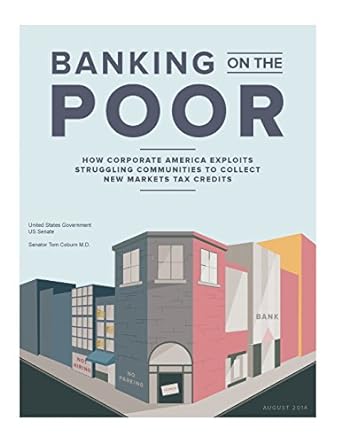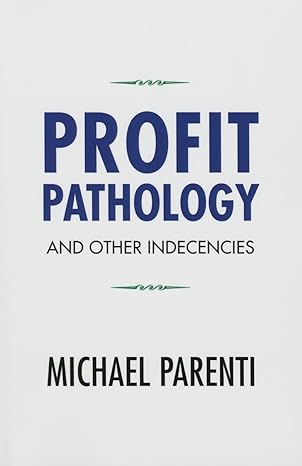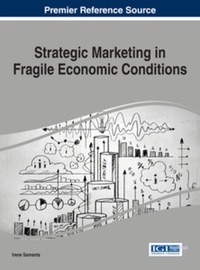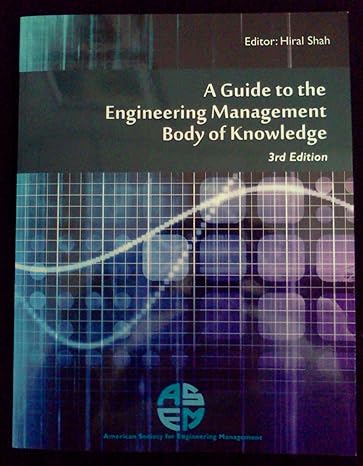Go back


Banking On The Poor How Corporate America Exploits Struggling Communities To Collect New Markets Tax Credits(1st Edition)
Authors:
United States Government US Senate, Senator Tom Coburn M.D.

Cover Type:Hardcover
Condition:Used
In Stock
Include with your book
Free shipping: April 03, 2024Popular items with books
Access to 3 Million+ solutions
Free ✝
Ask 10 Questions from expert
200,000+ Expert answers
✝ 7 days-trial
Total Price:
$0
List Price: $15.99
Savings: $15.99(100%)
Book details
ISBN: 1502991616, 978-1502991614
Book publisher: CreateSpace Independent Publishing Platform
Get your hands on the best-selling book Banking On The Poor How Corporate America Exploits Struggling Communities To Collect New Markets Tax Credits 1st Edition for free. Feed your curiosity and let your imagination soar with the best stories coming out to you without hefty price tags. Browse SolutionInn to discover a treasure trove of fiction and non-fiction books where every page leads the reader to an undiscovered world. Start your literary adventure right away and also enjoy free shipping of these complimentary books to your door.
Banking On The Poor How Corporate America Exploits Struggling Communities To Collect New Markets Tax Credits 1st Edition Summary: A billionaire’s fantasy island, Emmy award winning producers, Goldman Sachs, Broadway music fromHollywood, Starbucks, and even dolphins benefited from a tax credit intended to help struggling communities and lower-income Americans seeking new opportunities.Big banks collect millions of dollars in tax credits to help finance economic development projects, which have included doggie day cares, a sculpture in the desert, drive-in movie theaters, luxury hotels and fast food enterprises. While some of the projects are well intended, like health clinics, it is still difficult to measure if these tax expenditures are truly helping those seeking a hand up or simply subsidizing banks, corporations, and others who are already succeeding.The federal New Markets Tax Credit program was created to steer taxpayers dollars into banks that would in turn funnel financial assistance to businesses and developers in low-income communities to help create jobs. Yet, virtually every neighborhood, from Beverly Hills to the Hamptons, could qualify for the program. The New Markets Tax Credit (NMTC) has subsidized wealthy investors in nearly 4,000 projects, including car washes, bowling allies, parking lots and breweries. Many of these are wasteful and not a federal priority – such as an ice skating rink and a car museum - while others are corporations in little need of taxpayers’ handouts – such as chain restaurants like Subway and IHOP.One of the program’s projects is threatening not only to kill jobs but bankrupt an entire city. The cost to maintain the wellness center in Desert Hot Springs, California established with NMTC support has prompted across-the-board salary cuts and city officials are even considering elimination of the police department. This is not the impact the program was expected to have. Meanwhile, tens of thousands of dollars intended for the financially challenged clinic were spent to create a sculpture in the desert.Another project in an area of Atlanta where condominiums sell for millions of dollars—hardly the type of neighborhood most Americans would consider below poverty—NMTCs are being used to expand the world’s largest aquarium. With ticket prices costing nearly $65 for a 15 minute show, the real beneficiaries are Suntrust Bank, Wells Fargo and the Emmy award winning producers and Hollywood ensemble hired to develop the show, and of course the dolphins who live in the larger aquarium.The program is duplicative of other federal economic development programs both in the tax code and other government agencies. There are at least 23 community development tax expenditures costing taxpayers over $10 billion annually and 80 overlapping discretionary programs costing $6.5 billion annually, 28 of which are specifically designed to spur growth in new markets. Because of this redundancy, many projects and corporations are double dipping on taxpayers—receiving multiple federal subsidies through other grant programs and tax giveaways.This report, Banking on the Poor, exposes how the NMTC is just another tax code giveaway with little available evidence to demonstrate its effectiveness or compare its impact to the numerous other federal initiatives with similar goals. This tax credit intended to benefit the poor is instead lining the pockets of the well-off, such as big banks and other private investors that claim more than $1 billion in NMTC annually. These include JP Morgan Chase, Bank of America, and Wells Fargo, among others. Because it is funded by taxing the labor of Americans, NMTC is essentially a reverse Robin Hood scheme paid for with the taxes collected from working Americans to provide pay outs to big banks and corporations in the hop that those it took the money from might benefit.
Customers also bought these books
Frequently Bought Together
Top Reviews for Books
Mariam Ahmed
( 5 )
"Delivery was considerably fast, and the book I received was in a good condition."










